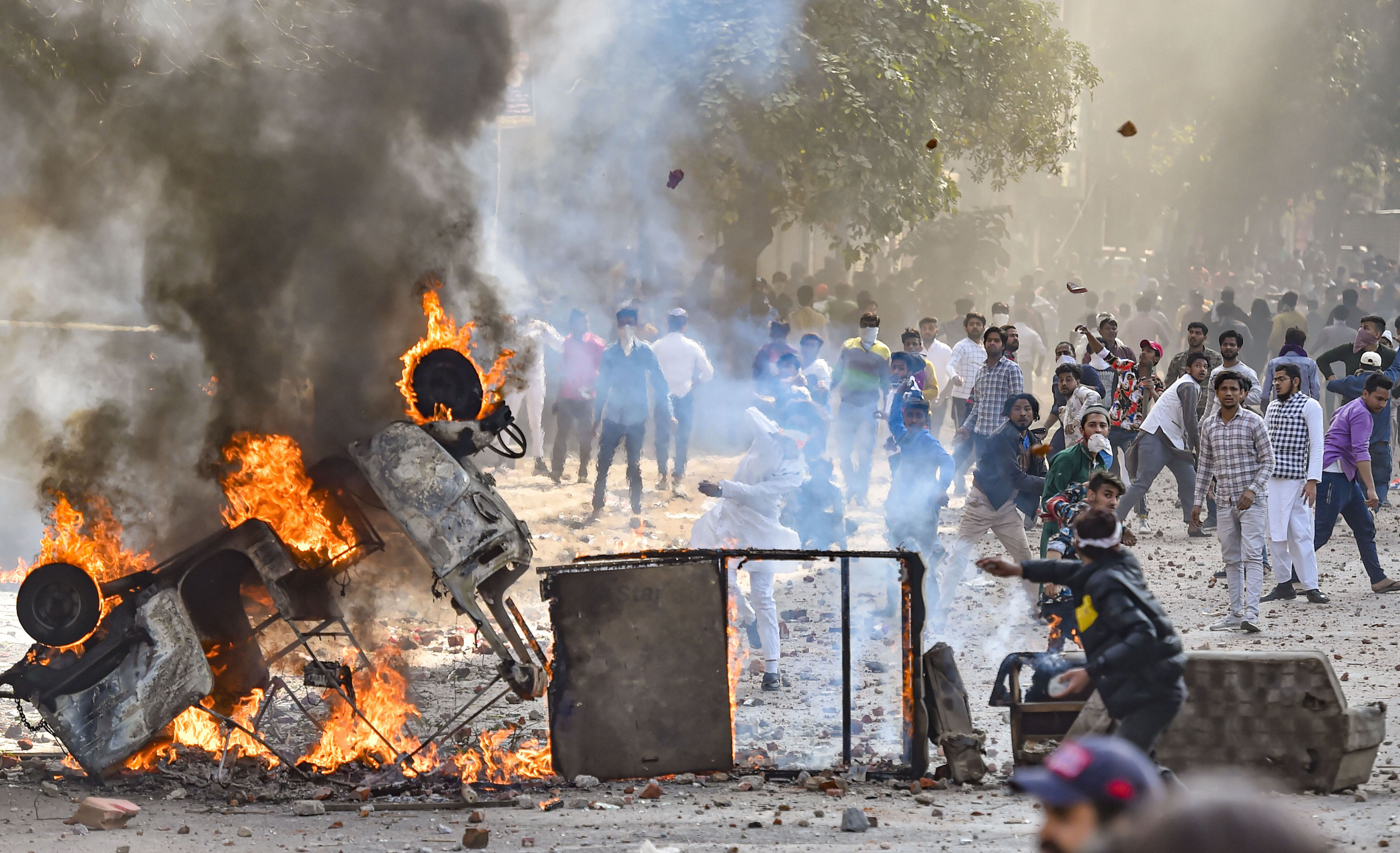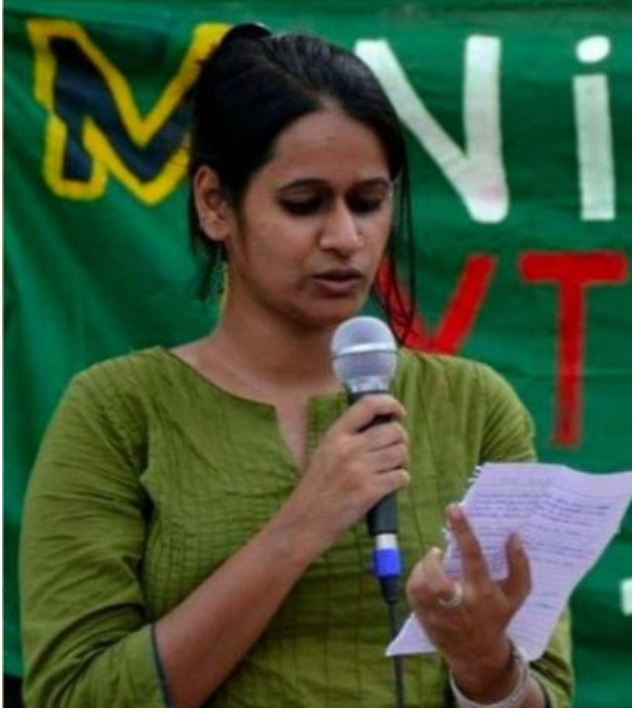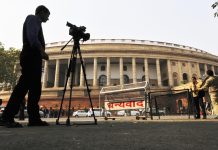
During the four-day riots beginning February 24, as Donald Trump was visiting India, 53 lives were lost and 755 were left injured. Despite the two trials, the Delhi Police has been able to obtain only 2 convictions so far. A report by Amitabh Srivastava
The farce that the Delhi Police has been engaging in the name of investigating the riots in North East Delhi in 2020 stands exposed as it announces a reward to find its own constable involved in the riots.
During the riots, a video had gone viral showing some policemen assaulting some Muslims and forcing them to sing the national anthem in Delhi’s Bhajanpura.
One of the men who died after the assault, reportedly of bullet injuries, was 23-year old Faizan, but his parents allege he died of police beating.
They went to court and in February 2022, the Delhi High Court expressed its displeasure in identifying the culprits who allegedly assaulted Faizan and the others with him and forced them to sing the national anthem.
According to reports in the media, the police maintains that after the case was taken over by the crime branch, it had questioned about 250 policemen and checked various documents and duty charts of policemen identified from outside during the riots to identify the culprit.
They were finally able to identify a head constable of the Delhi Armed Forces but denied his involvement. His polygraph test was negative but since it is not admissible in court, the Delhi Police has now announced a reward of Rs.1 lakh to anyone who can identify the culprit.
Apart from this, the senior officers of the crime branch have also asked the SIT formed by the Commissioner Rakesh Asthana to change the investigating officer in the case to get out of this embarrassing situation.
But this creates its own set of problems. Many other investigating officers in the case have already been changed in the case that hangs like an albatross around the neck of the Delhi Police Commissioner as his one year term come to an end this July end.
Only two weeks ago, he issued an order saying that all those officers who have been posted elsewhere (for their incompetence), must be present in the court whenever the issue of the riots is taken up for hearing.
The riots which began on February 23, 2020 continued for four days leaving 53 dead. To solve these cases, four special courts were created to fast track the cases.
But the results have become an embarrassment for the Delhi Police which comes directly under the Home Minister and it seems to be looking for an alibi.
They maintain that of the 758 cases, 440 have been solved and 2456 people arrested. Chargesheets have been filed in nearly 52 per cent cases against 1610 persons in these cases.
In view of allegations that Hindu provocateurs were not arrested, the Delhi Police told the media on record that 798 Hindus and 812 Muslims had been taken into custody for the riots which were basically against the passage of the CAA Bill by parliament in December 2019.
This effectively means that 42 per cent cases including 15 murders have not been tackled even till date.
Senior police officers who had to face the brunt in the Delhi High Court for this laxity are now telling the media under strict anonymity that they had acted in haste and that motivated complaints, lack of evidence and unclear information about location of crime and suspects had led to this embarrassing situation.
Under these circumstances, their prize catch Umar Khalid, former JNU leader, arrested under the UAPA for a speech in September 2020, seems to be the only face saving ‘culprit’ and the Delhi High Court also keeps on rejecting his bail plea again and again.
In his last appearance, his advocate told the court that the whole case against him was clearly based on hearsay from a witness which was yet to be corroborated.
The former student of Jawaharlal Nehru University (JNU) was arrested on September 13, 2020, in a case under the Unlawful Activities (Prevention) Act (UAPA).
“The prosecution really needs to make up its mind as to what is the case against me,” Khalid’s counsel said, adding,“I have to bear the brunt of two years of imprisonment because you have a statement.”

A bench of Justices Siddharth Mridul and Rajnish Bhatnagar heard the student activist’s petition challenging a trial court’s order that had rejected his bail application on March 24.
Lashing out at the controversial laws like sedition and UAPA, he said, “Basically UAPA is now this, you just get a person to make a statement and that is it. That is the difficulty in which I have been arraigned in this matter,” he charged.
In one of the hearings the Judges took objection to the word ‘ Jumla’ used against the Prime Minister by Khalid that really surprised people.
Talking about the case against Khalid, a senior police officer retired from a very active term with the Delhi Police, has admitted that holding Umar Khalid in jail would boomerang on them.
“Senior officers of the IPS who regularly interact with each other are clear that it is time for not only the sedition law but also for laws like UAPA to go from India because they have no place in a democratic set up like ours. We have to keep up with the modern trends in policing and jurisprudence,” he said.
Khalid’s case is also now directly linked with the fate of the sedition law that is pending for disposal in the Supreme Court.
Some history of the police cases and the Courts orders in the riot cases are given below to show how incompetent and biased they had been.
Even the Supreme Court had expressed its displeasure with the handling of the cases a year ago. It’s landmark order read, “The capital of the country can ill afford another repetition of the occurrence (Delhi riots) and the role of the Facebook in this context must be looked into by the powers that be”.
The exasperation of the Supreme Court was due to the fact that litigation had been going on for more than a year (two years now) about those arrested for the riots, most of whom had to be released for no evidence by the Delhi High Court.
This comes after the Delhi police commissioner SN Shrivastava boasted at a press conference in February 2021 that “extensive use of technologies like facial recognition, drone mapping, retrieving deleted data from electronic devices, CCTV footage, GPS, DNA and finger prints had helped in arresting the accused in northeast riots, leading to the arrest of 231 accused.
- 7 accused released on June 30, 2021
Sagir Ahmad, Naved Khan, Javed Khan, Arshad, Gulzar, Mohd Imran, Chand Babu1.
They were in jail on the charge of trying to murder Vinod Kumar of Brahmpuri. ASJ Amitabh Rawat said they can’t be incarcerated till the conclusion of the trial which would take a lot of time due to the pandemic. He said they had already spent one year in jail and were being released on bail. They are 7 of the 12 accused.
- On June 16, three students Devangana Kahita, Natasha Narwal and Asif Iqbal Tanha were granted bail by the Delhi High Court. The former 2 were arrested on May 29 under UAPA and Tanha also being part of a conspiracy. JNU students were members of Pinjra Tod while the third was from Jamia.
A Bench of justices Sidharth Mridul and Anup J Bhambhani while granting bail to Kahita, said, “We are constrained to say that it appears in its anxiety to suppress dissent and in the morbid fear that matters might get out of hand, the state has blurred the line between the constitutionally guaranteed right to protest and ‘terrorist action’. If such blurring gains traction, democracy will be in peril.”
- On June 21, Mohammad Furkan arrested for the murder of 24 year Salman was released by ASJ Vinod Yadav. The judge said that having spent one year in jail, he cannot be kept in jail because the other accused have not been arrested.
“The applicant has been arrested on the basis of CCTV footage at the scene of crime on date of the incident wearing religious caps and a bluish T shirt having white and red strips. He was made the accused on the basis of this footage. The judge said he has been implicated on the basis of one CCTV footage but nothing had been recovered so far.
- On March 17, the Delhi High Court granted bail to four men arrested for a case as there was no evidence such as CCTV footage, video or photo. Justice Suresh Kumar Sait said that none of the four had been particularly named.
- In an incident of February 24 last year. The judge noted that even though four police officers were examined by the Prosecution, none of them called a PCR or made a DD entry.
Three accused, Liyaqat Ali, Arshad Quyyom and Gulfam were arrested on March 23 while Irshsad Ahmad was arrested on March 18 for riots that broke out on February 24 in Chand Bagh area in Khazuri Khas.
The ongoing riot cases which have been taking prime place in the media had their own humorous angle.
During the trial of a JNU activist Natasha Narwal who is a Pinjra Tod member, the lawyers on both sides extensively used references from the Ramayana and Mahabharat to prove a point.
The Delhi police told court that just like the Sanskrit epic Mahabharata was a story of conspiracy, the northeast Delhi riots was also an alleged conspiracy whose ‘Dhritarashtra’, was yet to be identified.
The accused, who was seeking bail tried to match the police by saying this case cannot be like Ramayana “where we are going to wait 14 years to see if we can finally come out.”
Natasha’s counsel claimed that over the past eight odd hearings a ‘Chakravyuh’ had been prepared by the prosecution and the accused would attempt to become an ‘Abhimanyu’ and try to break out of it.
Referring to the accused’s contention that the chargesheet was the second biggest document after the ‘Mahabharata’, Special Public Prosecutor Amit Prasad, appearing for the police, said the WhatsApp group Delhi Protest Support Group (DPSG) was like the mythological character of ‘Sanjaya’, who was narrating all the events to ‘Dhritarashtra’.
Prasad told Additional Sessions Judge Amitabh Rawat that DPSG allegedly controlled and monitored all the protest sites and the intent was not a protest but a disruptive ‘Chakka Jaam’, with an end result of violence.
“The accused’s counsel said the chargesheet was the second biggest document after the ‘Mahabharata’. He had argued the Mahabharata was 22,000 pages and the charge sheet was 17,000 pages. I would like to point it out that ‘Mahabharata’ was a story of a conspiracy and incidentally this case is also that of a conspiracy. In ‘Mahabharata’, ‘Sanjaya’ was the one who was able to see everything.
“The ‘Sanjaya’ of this conspiracy was DPSG, ‘which was narrating everything to ‘Dhritarashtra’. The ‘Dhritarashtra’ here is yet to be identified,” the prosecutor submitted.
Advocate Adit Pujari, appearing for Narwal, said, “Over the past eight odd hearings, a ‘Chakravyuh’ has been prepared by the prosecution. Let’s be very clear the reason that this is being done is that the chargesheet does not really contain a prima facie case.
As his computer system crashed in the middle of the hearing, Pujari again commented on the bulkiness of the chargesheet and said that it was so heavy that it often slowed down the computer.
Prasad, whose system also crashed during the hearing, said,”The accused further argued that protest is not crime. I agree, but we have seen that clearly through and through the intent was not a protest, a disruptive Chakka jam and with clear indication that the end result was violence.”
In the submission made through video conferencing, the prosecutor said Narwals’ contention that the statements of the witnesses were extorted from them by putting pressure, was a “figment of imagination”.
The accused’s counsel had argued that the witnesses despite being aware did not report it at that time. “Let me say, this is a case where the witnesses have come forward and said they did not trust the local police at that time. We would not discuss the delay and that is a matter of trial,” he said.
“The statements recorded under section 164 (recording of statement before the magistrate) Code of Criminal procedure are corroborated with contemporaneous chat records. In any case, the credibility of the witnesses cannot be tested at this stage,” said the public prosecutor.
He further said ‘Chakka Jaam’ started on February 22 and chats, which were part of the chargesheet, showed that till February 23, nothing happened on the site where the protestors supporting the Citizenship Amendment Act were present.
“Narwal was brought on to the DPSG group after she was able to set up the protest site at Seelampur. She was part of the DPSG group which was controlling and monitoring all protest sites. She attended the alleged conspiratorial meeting of February 16 and February 17. The chats have clearly revealed that there was a proposal to incite violence,” said the public prosecutor.
“She was privy to the principal conspirators. She was coordinating with the Jamia Coordination Committee. Detailed elaborations not required on merits at this point. The prima facie case stands established,” the public prosecutor alleged.
Pujari alleged that 53 people died in the riots but the chargesheet revolved around the deaths of only three persons- Head Constable Ratan Lal, Rahul Solanki and Intelligence Bureau official Ankit Sharma.
Narwal was subsequently released as there was no evidence against her.













